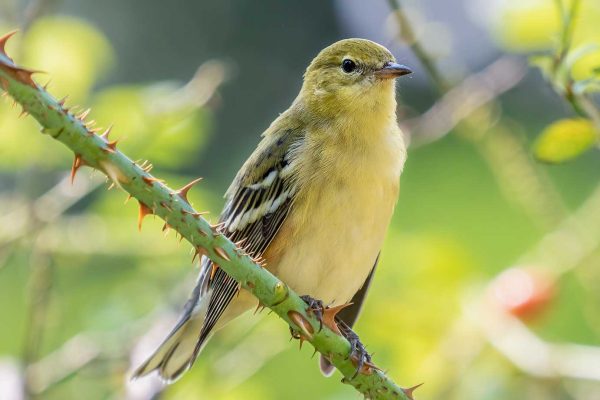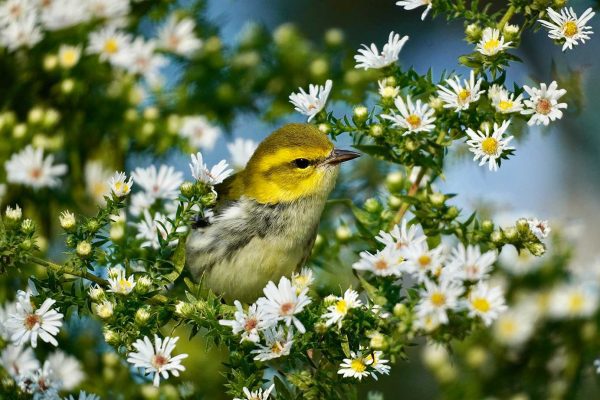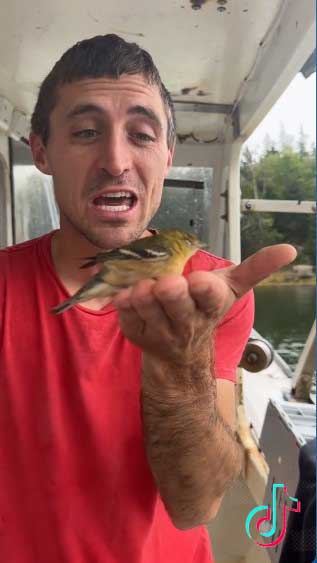
Bay-breasted warblers make the long journey from Canada and the northeastern U.S. to Central America for the winter, with many passing through Maine. No wonder they were caught on video by this lobsterman! (photo courtesy of Wikimedia Commons)
There was a lot of hype leading up to Lee. First is was a hurricane, then a tropical storm. Thankfully, harm of all sorts registered as a minimum. The same is true for vagrant bird sightings, as we’ve written about previously here at our Natural Resources Council of Maine blog.
But there was a storm-related “bird sighting” of another sort that did cause a flurry of excitement, regardless. It was the day the lobsterman saw birds falling from the sky.
We were tipped off to this celestial event when a reader of our weekly Boothbay Register column sent us a link to a wild TikTok video taken a few days before Hurricane Lee was expected to hit. In the video, a young Maine lobsterman is standing at the wheel of his boat, narrating about the massive numbers of small migrating land birds he and his lobstering crew were seeing offshore.
Some of the birds were trying to land on the boat; others, in the water. As the video begins, the lobsterman is hosting what looks like a Bay-breasted Warbler, exhausted, on his head! Soon we see little birds flying around the boat. The video reveals that the lobstering crew have been able to wrangle five or six under some netting, with the intent to bring them safely to shore. Among them, we could identify the bright yellow faces of several Black-throated Green Warblers and the gray cap and yellow breast of a Philadelphia Vireo.
Another segment in the same TikTok shows hundreds of birds swirling around the lights of a different boat.
The lobsterman speaking in the video expresses concern that these large numbers of birds may be an omen of how bad the impending hurricane might turn out to be. At the end of the piece, with the boat moored in a classic Maine harbor dotted with other lobster boats, a tiny and colorful Northern Parula Warbler, gleaming yellow and blue, lands on the head of his bemused sternman.
Like the lobster boat crew, you may be wondering: What was going on?
Many people don’t realize that most birds migrate at night. At the height of fall migration in the U.S., under favorable migration conditions, hundreds of millions of birds pass overhead as we sleep soundly in our beds. As dawn breaks, these migrating birds drop down into the landscape below them to eat, drink, and rest until the next night when, if they’ve gotten good rest and nourishment, they continue along their nocturnal migration journey.
Sometimes, birds flying near the coast drift out over the ocean during the night. As the sun begins to rise, they will look for a place to spend the day resting and replenishing their bodily reserves. Places like Monhegan Island are a magnet for birds in these circumstances, drawing them in as they search for a safe place to rest.
Boats, too, can become refuges for birds, especially when no land is in sight.
A few years ago, on a trip out to Monhegan, we had several Magnolia Warblers circle repeatedly around the boat, one landing briefly on the head of a surprised passenger.
What’s different in this TikTok video is the sheer volume of birds involved. For this to happen, there usually has to be clear skies and often light, northerly winds. This causes a high number of birds to fly aloft as they migrate at night. When a large volume of night-migrating birds encounters rainy and/or foggy conditions while still flying, they seek a place to land. They may suddenly find themselves in a disorienting swirl that makes it hard for them to distinguish the ground, trees, buildings, land, or water. At night in this situation, birds often are drawn to lights and will sometimes continue to swirl around and around them in their confusion.

Black-throated Green Warblers were some of the birds rescued by this lobsterman off the coast of Maine (photo by Fetafete, courtesy of Wikimedia Commons)
Lighthouse keepers along the Maine coast often reported finding lots of dead birds under such conditions at the base of the light. We ourselves have witnessed birds following the light of a lighthouse around and around at night.
The events shown in these videos probably are the result of migrating birds caught in these conditions. This would not have been as a result of the hurricane, although the eventual northward path of the storm was related to the same weather conditions that impacted the southward paths of those migrating birds. And hurricanes do have major impacts to migrating birds, sometimes likely killing large numbers under certain conditions. Other times they may just cause birds to change their path or hunker down and wait things out. Some larger birds, like certain shorebirds, may be able to take advantage of the stronger northerly winds on the western edge of a hurricane to get south even faster than normal.
Sometimes hurricanes suck up oceanic birds from farther south and essentially spit them out farther north or even over land when the storm weakens. Birders love to look for these way-out-of-range species that they would normally never get to see, at least not where they live. Although Lee failed to send super vagrants our way, it did provide a chance to capture an extraordinary bird event on video and, we hope, for others to learn a little something because of it!
—Jeff and Allison Wells












What a great article. I do enjoy reading Dr. Wells column in the Wiscasset Newspaper/Boothbay Register. Thank you to the NRCM for sharing this incredible story.
Thank you, Carol. Glad you enjoyed the piece, and thank you for your readership of the Boothbay Register column as well!
Allison and Jeff Wells